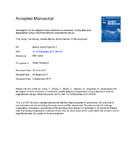JavaScript is disabled for your browser. Some features of this site may not work without it.
| dc.contributor.author | Jiang, Ying | |
| dc.contributor.author | Zhang, Yue | |
| dc.contributor.author | Banks, Charles | |
| dc.contributor.author | Heaven, Sonia | |
| dc.contributor.author | Longhurst, Philip | |
| dc.date.accessioned | 2017-09-08T09:11:23Z | |
| dc.date.available | 2017-09-08T09:11:23Z | |
| dc.date.issued | 2017-09-05 | |
| dc.identifier.citation | Jiang Y, Zhang Y, Banks C, Heaven S, Longhurst P, Investigation of the impact of trace elements on anaerobic volatile fatty acid degradation using a fractional factorial experimental design, Water Research, Volume 125, 15 November 2017, Pages 458-465 | en_UK |
| dc.identifier.issn | 0043-1354 | |
| dc.identifier.uri | http://dx.doi.org/10.1016/j.watres.2017.09.010 | |
| dc.identifier.uri | http://dspace.lib.cranfield.ac.uk/handle/1826/12458 | |
| dc.description.abstract | The requirement of trace elements (TE) in anaerobic digestion process is widely documented. However, little is understood regarding the specific requirement of elements and their critical concentrations under different operating conditions such as substrate characterisation and temperature. In this study, a flask batch trial using fractional factorial design is conducted to investigate volatile fatty acids (VFA) anaerobic degradation rate under the influence of the individual and combined effect of six TEs (Co, Ni, Mo, Se, Fe and W). The experiment inoculated with food waste digestate, spiked with sodium acetate and sodium propionate both to 10 g/l. This is followed by the addition of a selection of the six elements in accordance with a 26−2 fractional factorial principle. The experiment is conducted in duplicate and the degradation of VFA is regularly monitored. Factorial effect analysis on the experimental results reveals that within these experimental conditions, Se has a key role in promoting the degradation rates of both acetic and propionic acids; Mo and Co are found to have a modest effect on increasing propionic acid degradation rate. It is also revealed that Ni shows some inhibitory effects on VFA degradation, possibly due to its toxicity. Additionally, regression coefficients for the main and second order effects are calculated to establish regression models for VFA degradation. | en_UK |
| dc.language.iso | en | en_UK |
| dc.publisher | Elsevier | en_UK |
| dc.rights | Attribution-NonCommercial-NoDerivatives 4.0 International | |
| dc.rights.uri | http://creativecommons.org/licenses/by-nc-nd/4.0/ | |
| dc.subject | Anaerobic digestion | en_UK |
| dc.subject | Volatile fatty acids (VFA) degradation | en_UK |
| dc.subject | Trace elements | en_UK |
| dc.subject | Fractional factional design | en_UK |
| dc.title | Investigation of the impact of trace elements on anaerobic volatile fatty acid degradation using a fractional factorial experimental design | en_UK |
| dc.type | Article | en_UK |
| dc.identifier.cris | 18379935 |
Files in this item
This item appears in the following Collection(s)
-
Staff publications (SWEE) [2822]

